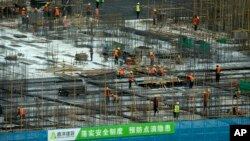China’s recent economic slowdown will have a negative but limited impact on the rest of Asia this year as China struggles to recover from the impact of the global pandemic and strict COVID Zero restrictions throughout 2022, according to analysts.
Beijing has set a modest 5% growth target for the country this year as it recovers from a sharp drop last year because of the COVID restrictions, but even that may be a challenge because of problems across its economy, said Alicia Garcia Herrero, chief economist for Asia Pacific at Natixis, a French investment bank.
“I think they will barely reach 5% and no more. That’s actually quite low compared to Southeast Asia. Certainly India, but also others,” Garcia Herrero told VOA, predicting that China will continue to diverge throughout 2024 as the rebound momentum from the end of COVID-19 pandemic fades.
China’s GDP target is higher than for developed economies of East Asia such as Taiwan and Japan, both between around 2% and 3%, but less than Vietnam and India which may see more than 6% growth this year, according to the Asian Development Bank.
China is facing a range of challenges from limited domestic and foreign investment this year and a drop in demand for its exports due to a worldwide economic slump.
Economic indicators in May such as industrial production and retail sales figures were also low, according to data from China’s National Bureau of Statistics, which also warned macro-economic challenges such as a high youth unemployment rate of over 20% “cannot be ignored.”
Exports fell 7.5% and imports fell 4.5% in May, according to NBS data, marking a reversal in fortunes from earlier in the year.
In a sign of Beijing’s concern, its central bank lowered lending rates this month to encourage more consumption and keep the economy humming along.
This range of factors means China’s recovery is going more slowly than analysts had hoped after it lifted COVID restrictions in late 2022, said Nick Marro, lead analyst for global trade at the Economist Intelligence Unit.
“Even as China's rebound peaked over the first quarter, we weren't seeing a lot of benefits spread out to the rest of Asia or other regions,” he said. “And as China's economy continues to lose momentum, that positive outlook for the reopening is I think going to disappoint a lot of people who are hoping, a much stronger lift from China's rebound than what has actually materialized.”
Unlike many other countries struggling with inflation, such as the U.S. and Europe, China is facing deflationary pressure due to a fall in global demand for its goods. Both export and wholesale prices are falling, which means Beijing can no longer rely on its pandemic strategy of “export[ing] itself out of the pandemic” on the back of strong Western demand, said Marro.
“Those dynamics are changing. Now that we're seeing a strong cooldown in the global demand landscape, and a correction in global trade so that export strength is no longer going to be a pillar for Chinese economic growth,” he said.
Meanwhile, manufactures are still struggling through the impact of 2022 COVID Zero restrictions and the Shanghai lockdown on supply chains, according to Gavekal Dragonomics research.
China’s growth in 2023 has instead been largely driven by consumption, a highly unusual situation, as it typically relies on exports, real estate, and construction to fuel its economy, said Christopher Beddor, deputy China researcher at Gavekal Dragonomics.
This is bad news for neighbors that export intermediate goods and raw materials that are used in its manufacturing industry, he said. Consumption-driven growth also has a much smaller “multiplier” than other kinds of growth, which means it will have a weaker impact on the rest of the economy.
“China’s economy and growth this year are going to lead to a very different impact on other countries in the region compared to previous cycles that were driven by other areas of the economy,” Beddor said.
The one major bright spot for the region is Chinese tourism is surging thanks to three years of pent-up demand. Gaveskal Dragonomics predicts tourism could rebound from $118 billion in 2022 to nearly $100 billion more this year, bringing it close to pre-pandemic levels of $251 billion in 2019 as Chinese tourists return to popular countries like Japan, South Korea, Thailand, and Singapore.








